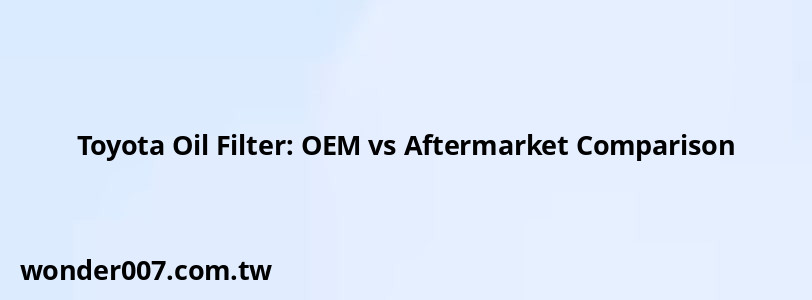Toyota Oil Filter: OEM vs Aftermarket Comparison

When it comes to maintaining your Toyota vehicle, one of the key components to consider is the oil filter. The choice between OEM (Original Equipment Manufacturer) oil filters and aftermarket options can significantly affect your vehicle's performance and longevity. This article will explore the differences, advantages, and disadvantages of each type to help you make an informed decision.
Understanding OEM Oil Filters
OEM oil filters are manufactured by the same company that produces the original filters for Toyota vehicles. They are designed to meet the exact specifications set by Toyota, ensuring a perfect fit and optimal performance.- Quality Assurance: OEM filters undergo rigorous quality control processes, which means they are built to last and perform effectively under various conditions.
- Compatibility: Since they are specifically made for Toyota models, these filters ensure compatibility with your vehicle’s engine and oil system.
- Warranty Protection: Using OEM parts can help maintain your vehicle's warranty, as they meet the manufacturer's standards.
However, there are some considerations:
- Cost: OEM filters tend to be more expensive than their aftermarket counterparts.
- Filtration Efficiency: Some users argue that while OEM filters are reliable, their filtration efficiency may not be as high as certain high-end aftermarket options.
Exploring Aftermarket Oil Filters
Aftermarket oil filters are produced by third-party manufacturers and can vary widely in quality. Some are designed to fit multiple vehicle makes and models, offering a broader selection.- Cost-Effective: Generally, aftermarket filters are less expensive than OEM options, making them a popular choice for budget-conscious consumers.
- Variety of Options: Aftermarket brands often offer features that may not be available in OEM filters, such as extended change intervals or enhanced filtration technology.
- Potential for Higher Performance: Certain aftermarket filters are designed to exceed OEM specifications, potentially offering better filtration and flow rates.
However, there are risks associated with using aftermarket products:
- Quality Variability: The quality of aftermarket filters can vary significantly between manufacturers. Some may use inferior materials that could compromise engine protection.
- Compatibility Issues: Because they are not made specifically for your vehicle model, there may be compatibility concerns that could affect performance or lead to installation difficulties.
Key Differences Between OEM and Aftermarket Filters
| Feature | OEM Oil Filters | Aftermarket Oil Filters |
|---|---|---|
| Manufacturing | Made by Toyota or approved suppliers | Made by various third-party manufacturers |
| Quality Control | High-quality standards | Varies widely; some may exceed OEM |
| Cost | Generally higher | Typically lower |
| Compatibility | Designed specifically for Toyota vehicles | May fit multiple models but not always optimized |
| Warranty Protection | Maintains warranty coverage | May void warranty if not compliant with specifications |
Conclusion
Choosing between Toyota OEM oil filters and aftermarket options ultimately depends on your specific needs and priorities. If you prioritize guaranteed compatibility and quality assurance, OEM filters are a solid choice. However, if you seek cost savings and potentially enhanced performance, high-quality aftermarket filters could be worth considering.
Regardless of your choice, regular maintenance and timely oil changes are essential for ensuring the longevity and efficiency of your Toyota engine.
FAQs About Toyota Oil Filters
- Are OEM oil filters worth the extra cost?
Yes, they provide guaranteed compatibility and quality assurance. - Can I use aftermarket oil filters without voiding my warranty?
If they meet manufacturer specifications, yes; however, always check your warranty terms. - How often should I change my oil filter?
Typically every 5,000 to 7,500 miles or as recommended in your owner's manual.
Related Posts
-
Water Pump Replacement for 2007 Toyota RAV4: A Complete Guide
30-01-2025 • 200 views -
Oil Drain Plug Torque Chart for Toyota Vehicles
27-01-2025 • 321 views -
Toyota Camry Car Alarm Issues: Causes and Fixes
27-01-2025 • 255 views -
Best Spark Plugs for 2007 Toyota Camry: Top Choices
27-01-2025 • 140 views -
Toyota RAV4: Troubleshooting Whining Noise When Accelerating
30-01-2025 • 222 views
Latest Posts
-
2015 Chevy Traverse AC Recharge Port Location
01-02-2025 • 418 views -
Rear Brake Caliper Piston Won't Compress
01-02-2025 • 361 views -
Are O2 Sensors Covered Under Warranty
01-02-2025 • 378 views -
Power Steering Fluid Leak On Passenger Side
01-02-2025 • 461 views -
How To Turn Off Paddle Shifters Mercedes
01-02-2025 • 387 views
Popular Posts
-
Hino Warning Lights: Understanding Dashboard Alerts
26-01-2025 • 795 views -
Toyota Hiace: Fuel Efficiency Insights for 2025
26-01-2025 • 646 views -
V12 Engine Costs: What You Need to Know
26-01-2025 • 688 views -
EPC Light: Understanding Causes and Solutions
26-01-2025 • 1065 views -
Power Steering and ABS Light On: Causes and Solutions
27-01-2025 • 650 views
